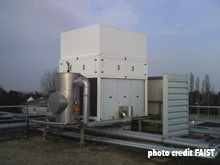How to reduce the noise of a heat pump ? This is a question that may arise for an architect, an installer of Heating Ventilation Air Conditioning (HVAC), a homeowner concerned about his acoustic comfort or that of his neighborhood, or a neighbor being exasperated, when it is not a co-ownership trustee that one solicits to remedy a problem of noise nuisance.
Because a heat pump is an equipment that is by nature a source of noise (due to the operation of components such as compressors, fans) and is often close enough to homes or housing so that its sound emissions are very noticeable, even by people who do not especially have keen hearing.
It is not uncommon for emergence i.e. the difference between the A-weighted equivalent continuous pressure levels of the ambient noise - heat pump in operation - and the residual noise - in the absence of the noise generated by the heat pump, but measured at complainant’s place of residence over the period of operation of the heat pump - reaches 10 or even 15 decibels, which is then an exceeding of the regulatory limit.
For the period 7 am - 10 pm (except Sundays and public holidays), the permissible emergence is 6 dB (A) for an ambient noise level between 35 dB (A) and 45 dB (A) and 5 dB ( A) for an ambient noise level greater than 45 dB (A).
For the period 22h - 7h (and for Sundays & public holidays), the permissible emergence is 4 dB (A) for an ambient noise level between 35 dB (A) and 45 dB (A) and 3 dB (A) for an ambient noise level greater than 45 dB (A).
In relation to the noise of a heat pump, an aggravating circumstance related to the nuisance of local residents may be the presence of a stong tone when the difference in level between the band of third octave and the four nearest third octave bands (the two immediately lower bands and the two immediately higher bands) reach or exceed the following levels for the band: 10 dB 50 Hz to 315 Hz, 5 dB 400 Hz at 1250 Hz, 5 dB from 50 Hz to 315 Hz.
In addition, the normalized sound pressure level, LnAT, of the noise of a heat pump (heat pump) must not exceed certain limits that depend on the room in question: in a residential building e.g. 35 dB (A) in a main room, in an educational institution e.g. 33 dB (A) in a library, in a health facility e.g. 30 dB (A) in an accommodation, in a hotel e.g. 30 dB (A) in a room.
Such limits are sometimes exceeded.
In all these situations, it is necessary to reduce the noise of the heat pump causing these disturbances for neighborhood.
The principle is to install devices to separate the air flow related to the inlet - often: on the side parts of the heat pump, when it comes to large units, the air in front being guided to heat exchangers - from the one linked to the discharge - often: in the upper part, when fans are provided whose blades are then in a horizontal plane when it is a question of large units - while preventing the propagation of noise.
Absorption silencers consisting of a metallic duct (usually made of steel) and absorbent separators (a.k.a. baffles) with a metal frame (also: usually made of steel) and with a lining made of mineral wool lining (then covered with a anti-defibering veil) or made of polyester wool (then with a special surface treatment) ensure this functionality.
The sizing of such silencers (generally: with a rectangular section) intended to reduce the noise of a heat pump must be carefully performred because their acoustic performance should not be accompanied by a total pressure loss being too important (the pressure drop available for silencers is often almost zero in such cases) and the air velocity must be kept low enough not to generate too much self noise.
A simulation software such as SILDIS® is then a valuable tool because reliable and accurate to optimize the technological choices related to these soundproofing equipment since its Module 1 allows the prediction of acoustic and aeraulic performances of silencers.
In case of need, the continuity of the acoustic insulation (between the silencer at the inlet and the silencer at the discharge) is ensured by metallic soundproofing panels (usually made of steel) with a mineral wool lining (then covered with a anti-defibering cloth) or polyester wool (then with a special surface treatment) and with a perforated protective sheet. If necessary, easily removable parts for maintenance or acoustic door blocks allowing access must be envisaged.
In some contexts, to reduce the noise of a heat pump, the installation of silencers at the discharge (only) is sufficient (they can then have a circular section), the effectiveness of the soundproofing system being able to be completed by a screen built with metal acoustic insulation panels (absorbent on one side) as mentioned above.
|
How to reduce the noise of a heat pump |
What is true for the soundproofing of a heat pump is also true in the case of air conditioning, air coolers, air condensers, refrigeration units and other Heating Ventilation Air Conditioning (HVAC) equipment for domestic or industrial use.
ITS can size and market soundproofing equipment to reduce the noise of a heat pump and also for many other noisy hardware.
Spread the word !
